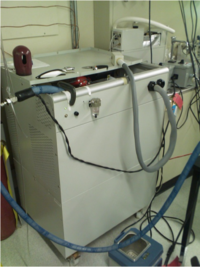Selected-ion flow-tube mass spectrometry

Hi kiddo, do you know how scientists figure out what things are made of? They use something called mass spectrometry!
One way to do mass spectrometry is with something called selected-ion flow-tube mass spectrometry. That’s a really big word, but let me explain what it means.
First, scientists take a tiny sample of the thing they want to study (let’s say it’s a piece of a rock). Then they put it into a machine that breaks it into really tiny pieces called ions. These ions have a positive or negative charge, depending on their type.
Next, the ions go into something called a flow-tube. This is a special place where the ions will be separated based on their size and charge. Some ions are bigger or smaller than others, and this helps scientists figure out what they are made of.
Now comes the “selected-ion” part. Scientists choose a specific type of ion that they want to study more closely. They use a special tool to pull out these ions and send them to another machine.
In this machine, the selected ions are measured very carefully. Scientists can see exactly how much they weigh and what kind of atom they’re made of. This helps them figure out what the rock (or whatever they’re studying) is made of!
So you see, selected-ion flow-tube mass spectrometry is a way that scientists can look at really tiny things and figure out what they are made of. It’s like a puzzle, and by looking at each piece, scientists can put it all together and learn something new!
One way to do mass spectrometry is with something called selected-ion flow-tube mass spectrometry. That’s a really big word, but let me explain what it means.
First, scientists take a tiny sample of the thing they want to study (let’s say it’s a piece of a rock). Then they put it into a machine that breaks it into really tiny pieces called ions. These ions have a positive or negative charge, depending on their type.
Next, the ions go into something called a flow-tube. This is a special place where the ions will be separated based on their size and charge. Some ions are bigger or smaller than others, and this helps scientists figure out what they are made of.
Now comes the “selected-ion” part. Scientists choose a specific type of ion that they want to study more closely. They use a special tool to pull out these ions and send them to another machine.
In this machine, the selected ions are measured very carefully. Scientists can see exactly how much they weigh and what kind of atom they’re made of. This helps them figure out what the rock (or whatever they’re studying) is made of!
So you see, selected-ion flow-tube mass spectrometry is a way that scientists can look at really tiny things and figure out what they are made of. It’s like a puzzle, and by looking at each piece, scientists can put it all together and learn something new!
